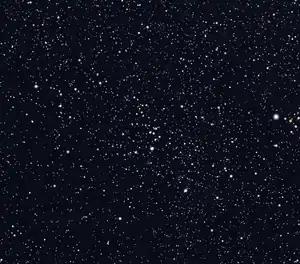NGC 6208
NGC 6208 ist ein offener Sternhaufen (Typdefinition „II1m“) im Sternbild Altar und etwa 940 Parsec von der Erde entfernt. Er wurde am 28. Juli 1834 von James Dunlop mit einem 9-Zoll-Spiegelteleskop entdeckt, der dabei „a round, faint nebula, about 1′ diameter, with three small stars in it; a bright star south of the nebula“[4] notierte.
 | |
| {{{Bildtext}}} | |
| AladinLite | |
| Sternbild | Altar |
| Position Äquinoktium: J2000.0 | |
|---|---|
| Rektaszension | 16h 49m 28,2s [1] |
| Deklination | -53° 43′ 42″ [1] |
| Erscheinungsbild | |
| Klassifikation | II1m [2] |
| Helligkeit (visuell) | 7,2 mag [2] |
| Winkelausdehnung | 18,0′ [2] |
| Physikalische Daten | |
| Radialgeschwindigkeit | −32 km/s |
| Entfernung [3] | ca. 3100 Lj (939 pc) |
| Geschichte | |
| Entdeckt von | James Dunlop |
| Entdeckungszeit | 28. Juli 1826 |
| Katalogbezeichnungen | |
| NGC 6208 • Cr 313 • ESO 179-SC14 • GC 4232 • h 3646 • OCL 964 | |
John Herschel notierte bei zwei Beobachtungen mit einem 18-Zoll-Spiegelteleskop im Jahr 1847 „a pretty insulated milky way cluster, class VII of large stars; 8′ diameter; stars 9..12th magnitude“ und „cluster class VII; rich; not much compressed in the middle; more than fills field; stars 11.14th mag but chiefly small“[4].[5]
Weblinks
Einzelnachweise
- NASA/IPAC EXTRAGALACTIC DATABASE
- SEDS: NGC 6208
- WEBDA-Seite zu NGC 6208
- Auke Slotegraaf: NGC 6208. Deep Sky Observer's Companion, abgerufen am 1. Juli 2016 (englisch).
- Seligman
This article is issued from Wikipedia. The text is licensed under Creative Commons - Attribution - Sharealike. The authors of the article are listed here. Additional terms may apply for the media files, click on images to show image meta data.